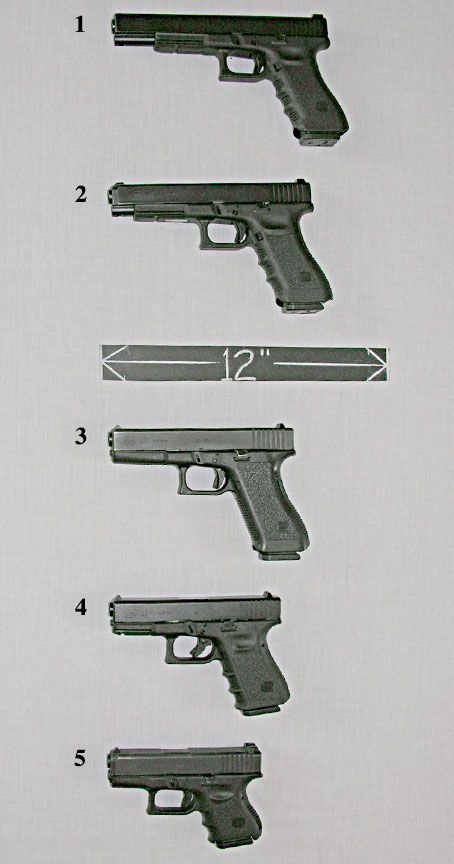Defensive Handguns
|
- Revolvers The
caliber of these revolvers: All are .357 Magnum/.38
Special
- Semi-automatics The
caliber of these semi-automatics: Are all .40 caliber
|
| |
|
Revolvers |
Revolvers vs semi-automatics: The revolver holds
much less ammunition, these are 5, 6, and 7 shot
models. But they are extremely reliable, they fire
every time the trigger is pulled, almost never jam,
and are easily maintained. All but one, #9, are both
double-action and single-action (DA/SA). Meaning
the hammer can be cocked back with the thumb to fire
the weapon … single action. This reduces the
trigger pull to 2-4 pounds and assists in carefully
aimed shots at distant targets. Or the trigger can
be pulled without cocking the weapon … double
action. This increases the trigger pull to 7-12 pounds
and allows the weapon to be fired with less accuracy
but very quickly at close-up targets. #9 is a double-action-only
weapon (DAO). It has no exposed hammer and can only
be fired double action. The mix of revolvers below
are from five different manufacturers and all are
made of steel (black or stainless) except #8 and
#9 … those two are composed of lightweight
titanium. There is a mixture of adjustable and fixed
sights, barrels from 1” to 6.5”, and
nine different configurations of grips. After firing
all of these, the shooter will have an excellent
idea as to what action, weight, barrel length, sight
configuration, and grip is going to suit him/her
best. Or it might determine that the student prefers
a semi-automatic? Either way it will remove all guesswork
when deciding which handgun to buy.
- Ruger GP-100,
large-frame, 6-shot, 6.5” barrel,
stainless steel, with adjustable sights, and partial
walnut grips. Exceptionally accurate.
- Taurus
Standard, large frame, 6-shot, 6”, barrel,
stainless steel, with adjustable sights, and Hogue
custom grips. Exceptionally accurate.
- Rossi
Six, medium frame, 6-shot, 6” barrel, stainless
steel, with adjustable sights, (Rossi is especially
suited for smaller hands), lighter than a large
frame. Exceptionally accurate.
- Smith & Wesson Companion,
medium frame, 6-shot, 4” barrel, stainless
steel, with fixed sights (fixed sights reduces the
cost of a handgun). A 4” barrel is considered “all
purpose” – long enough to be quite
accurate and short enough to not be unwieldy.
- Taurus “Tracker,” medium
frame, 7-shot, 4” barrel, stainless steel,
with adjustable sights, a ported barrel, and a shock-absorbing
grip. Especially accurate for a 4” barrel (also
comes in 2”, 6”, and 7” versions).
An excellent 7-shot revolver for the money. A favorite
of a large percentage of our students.
- Ruger
SP-101, small “heavy-frame (very solid),” 5-shot,
2” barrel, stainless steel, with fixed sights
and small rubber grips. Small enough to be concealed,
heavy enough to reduce magnum recoil significantly,
very durable.
- Charter Arms “Pug
.357,” small frame, 5-shot, 2” barrel,
black steel, fixed sights, a ported barrel, “full
hand” grip to reduce recoil and increase
accuracy. Quite inexpensive and very concealable.
- Taurus “Titanium,” 5-shot,
adjustable sights (very rare on a snub-nose), 14
oz., “shrouded hammer” – the hammer
is protected so as not to snag on clothing when withdrawn,
1.5” barrel, extremely concealable. Several
other manufacturers make a “shrouded hammer” titanium
DA/SA handgun.
- Smith & Wesson M&P
340, small frame, 5-shot, 1.7” barrel, 24/7
Tritium Night fixed sights, internal hammer (double
action only), will not hammer-snag when withdrawing
from clothing, laser grips, recoil cushion on rear
of grips. Extremely concealable … arguably
the most concealable .357 revolver on the global
market at this time.
Sidebar: S&W also now makes a .357 340-PD, also
M&P (to military and police specifications),
with an exposed hammer in Scandium that has a weight
of 10.8 oz.
|
 |
|
|
|
Semi-automatics |
Semi-automatics vs revolvers:
Lots of ammo' in the semi-auto, even the little
G27 (#5) has 10 rounds. It always shoots on single
action (2-7 pound trigger pull), it can be reloaded
very quickly with another magazine. But it can
jam and one must understand how to quickly rectify
that situation and it has a lot of moving parts
and is more labor/time intensive to maintain than
a revolver. The Glock .40 cal. handguns, compared
below in their five different sizes below, are
used in the class. Glocks, for their simplicity
(the average semi-auto' has 71 parts, a Glock has
28) and no on/off safety to complicate things --
the safety is deactivated automatically as the
trigger is pulled. Forty caliber for the happy
medium in defensive stopping power. Some 91% of
all federal, state, and municipal law enforcement
officers are issued weapons in .40 caliber, many
of them Glocks -- for good reason. The Glocks in
this class have a mixture of notched/target sights
and 3-dot tactical night sights, you will shoot
both.
- Model 24, compensated "long slide," with
a 6.1" barrel, 4.5 pound competition trigger,
extended magazine release, and a magazine that
holds 15 rounds.
- Model 35, compensated slide,
5.3" barrel, 4.5 pound competition trigger,
extended magazine release and a magazine that holds
15 rounds.
- Model 22, Called a "Standard" Glock
because it is the issue handgun for so many organizations.
A magazine that holds 15 rounds, 'has a 4.5"" barrel
and a 5.5 pound standard trigger.
- Model 23 "Compact." Small
enough to be used as a concealed-carry weapon.
Standard 5.5 pound trigger, 4" barrel, 13
round magazine. Often carried by plain clothes
officers.
- Model 27 "Sub Compact." Standard
5.5 pound trigger, 3.5" barrel, 9 round magazine.
'Can be concealed quite easily, often a "backup" weapon
for law enforcement officers who are carrying the
Model 22 as their primary weapon.
|
 |
|
|
| |
|
|
|
|